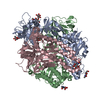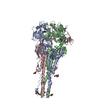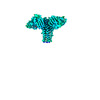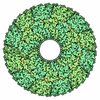[English] 日本語
 Yorodumi
Yorodumi- EMDB-41642: Langya henipavirus postfusion F protein in complex with 4G5 Fab, ... -
+ Open data
Open data
- Basic information
Basic information
| Entry |  | |||||||||
|---|---|---|---|---|---|---|---|---|---|---|
| Title | Langya henipavirus postfusion F protein in complex with 4G5 Fab, local refinement of the viral membrane proximal region | |||||||||
 Map data Map data | ||||||||||
 Sample Sample |
| |||||||||
 Keywords Keywords | Langya / henipavirus / fusion protein / postfusion / LayVF / SSGCID / VIRAL PROTEIN-IMMUNE SYSTEM complex / Structural Genomics / Seattle Structural Genomics Center for Infectious Disease | |||||||||
| Function / homology | Precursor fusion glycoprotein F0, Paramyxoviridae / Fusion glycoprotein F0 / fusion of virus membrane with host plasma membrane / viral envelope / host cell plasma membrane / virion membrane / plasma membrane / Fusion glycoprotein F0 Function and homology information Function and homology information | |||||||||
| Biological species |  Langya virus / Langya virus /  | |||||||||
| Method | single particle reconstruction / cryo EM / Resolution: 3.6 Å | |||||||||
 Authors Authors | Wang Z / Seattle Structural Genomics Center for Infectious Disease (SSGCID) / Veesler D | |||||||||
| Funding support |  United States, 1 items United States, 1 items
| |||||||||
 Citation Citation |  Journal: Proc Natl Acad Sci U S A / Year: 2024 Journal: Proc Natl Acad Sci U S A / Year: 2024Title: Structure and design of Langya virus glycoprotein antigens. Authors: Zhaoqian Wang / Matthew McCallum / Lianying Yan / Cecily A Gibson / William Sharkey / Young-Jun Park / Ha V Dang / Moushimi Amaya / Ashley Person / Christopher C Broder / David Veesler /  Abstract: Langya virus (LayV) is a recently discovered henipavirus (HNV), isolated from febrile patients in China. HNV entry into host cells is mediated by the attachment (G) and fusion (F) glycoproteins which ...Langya virus (LayV) is a recently discovered henipavirus (HNV), isolated from febrile patients in China. HNV entry into host cells is mediated by the attachment (G) and fusion (F) glycoproteins which are the main targets of neutralizing antibodies. We show here that the LayV F and G glycoproteins promote membrane fusion with human, mouse, and hamster target cells using a different, yet unknown, receptor than Nipah virus (NiV) and Hendra virus (HeV) and that NiV- and HeV-elicited monoclonal and polyclonal antibodies do not cross-react with LayV F and G. We determined cryoelectron microscopy structures of LayV F, in the prefusion and postfusion states, and of LayV G, revealing their conformational landscape and distinct antigenicity relative to NiV and HeV. We computationally designed stabilized LayV G constructs and demonstrate the generalizability of an HNV F prefusion-stabilization strategy. Our data will support the development of vaccines and therapeutics against LayV and closely related HNVs. | |||||||||
| History |
|
- Structure visualization
Structure visualization
| Supplemental images |
|---|
- Downloads & links
Downloads & links
-EMDB archive
| Map data |  emd_41642.map.gz emd_41642.map.gz | 398.5 MB |  EMDB map data format EMDB map data format | |
|---|---|---|---|---|
| Header (meta data) |  emd-41642-v30.xml emd-41642-v30.xml emd-41642.xml emd-41642.xml | 20.4 KB 20.4 KB | Display Display |  EMDB header EMDB header |
| Images |  emd_41642.png emd_41642.png | 25.2 KB | ||
| Filedesc metadata |  emd-41642.cif.gz emd-41642.cif.gz | 6.3 KB | ||
| Others |  emd_41642_additional_1.map.gz emd_41642_additional_1.map.gz emd_41642_half_map_1.map.gz emd_41642_half_map_1.map.gz emd_41642_half_map_2.map.gz emd_41642_half_map_2.map.gz | 211.5 MB 391.1 MB 391.1 MB | ||
| Archive directory |  http://ftp.pdbj.org/pub/emdb/structures/EMD-41642 http://ftp.pdbj.org/pub/emdb/structures/EMD-41642 ftp://ftp.pdbj.org/pub/emdb/structures/EMD-41642 ftp://ftp.pdbj.org/pub/emdb/structures/EMD-41642 | HTTPS FTP |
-Validation report
| Summary document |  emd_41642_validation.pdf.gz emd_41642_validation.pdf.gz | 958.9 KB | Display |  EMDB validaton report EMDB validaton report |
|---|---|---|---|---|
| Full document |  emd_41642_full_validation.pdf.gz emd_41642_full_validation.pdf.gz | 958.5 KB | Display | |
| Data in XML |  emd_41642_validation.xml.gz emd_41642_validation.xml.gz | 18.2 KB | Display | |
| Data in CIF |  emd_41642_validation.cif.gz emd_41642_validation.cif.gz | 21.5 KB | Display | |
| Arichive directory |  https://ftp.pdbj.org/pub/emdb/validation_reports/EMD-41642 https://ftp.pdbj.org/pub/emdb/validation_reports/EMD-41642 ftp://ftp.pdbj.org/pub/emdb/validation_reports/EMD-41642 ftp://ftp.pdbj.org/pub/emdb/validation_reports/EMD-41642 | HTTPS FTP |
-Related structure data
| Related structure data |  8tvhMC  8tvbC  8tveC  8tvfC  8tvgC  8tviC  8vwpC C: citing same article ( M: atomic model generated by this map |
|---|---|
| Similar structure data | Similarity search - Function & homology  F&H Search F&H Search |
- Links
Links
| EMDB pages |  EMDB (EBI/PDBe) / EMDB (EBI/PDBe) /  EMDataResource EMDataResource |
|---|---|
| Related items in Molecule of the Month |
- Map
Map
| File |  Download / File: emd_41642.map.gz / Format: CCP4 / Size: 421.9 MB / Type: IMAGE STORED AS FLOATING POINT NUMBER (4 BYTES) Download / File: emd_41642.map.gz / Format: CCP4 / Size: 421.9 MB / Type: IMAGE STORED AS FLOATING POINT NUMBER (4 BYTES) | ||||||||||||||||||||||||||||||||||||
|---|---|---|---|---|---|---|---|---|---|---|---|---|---|---|---|---|---|---|---|---|---|---|---|---|---|---|---|---|---|---|---|---|---|---|---|---|---|
| Projections & slices | Image control
Images are generated by Spider. | ||||||||||||||||||||||||||||||||||||
| Voxel size | X=Y=Z: 0.9835 Å | ||||||||||||||||||||||||||||||||||||
| Density |
| ||||||||||||||||||||||||||||||||||||
| Symmetry | Space group: 1 | ||||||||||||||||||||||||||||||||||||
| Details | EMDB XML:
|
-Supplemental data
-Additional map: Unsharpened
| File | emd_41642_additional_1.map | ||||||||||||
|---|---|---|---|---|---|---|---|---|---|---|---|---|---|
| Annotation | Unsharpened | ||||||||||||
| Projections & Slices |
| ||||||||||||
| Density Histograms |
-Half map: #2
| File | emd_41642_half_map_1.map | ||||||||||||
|---|---|---|---|---|---|---|---|---|---|---|---|---|---|
| Projections & Slices |
| ||||||||||||
| Density Histograms |
-Half map: #1
| File | emd_41642_half_map_2.map | ||||||||||||
|---|---|---|---|---|---|---|---|---|---|---|---|---|---|
| Projections & Slices |
| ||||||||||||
| Density Histograms |
- Sample components
Sample components
-Entire : Langya henipavirus postfusion fusion protein in complex with 4G5 Fab
| Entire | Name: Langya henipavirus postfusion fusion protein in complex with 4G5 Fab |
|---|---|
| Components |
|
-Supramolecule #1: Langya henipavirus postfusion fusion protein in complex with 4G5 Fab
| Supramolecule | Name: Langya henipavirus postfusion fusion protein in complex with 4G5 Fab type: complex / ID: 1 / Parent: 0 / Macromolecule list: #3, #1-#2 |
|---|---|
| Source (natural) | Organism:  Langya virus Langya virus |
-Macromolecule #1: 4G5 light chain
| Macromolecule | Name: 4G5 light chain / type: protein_or_peptide / ID: 1 / Number of copies: 3 / Enantiomer: LEVO |
|---|---|
| Source (natural) | Organism:  |
| Molecular weight | Theoretical: 11.655939 KDa |
| Recombinant expression | Organism:  |
| Sequence | String: DIQMTQSPAS LSASVGETVT ITCRASGNIH NYLAWYQQKQ GKSPQLLVYS AKTLADGVPS RFSGSGSGTQ YSLKINSLQP EDFGSYYCQ HFWSSPRTFG GGTKLEIK |
-Macromolecule #2: 4G5 heavy chain
| Macromolecule | Name: 4G5 heavy chain / type: protein_or_peptide / ID: 2 / Number of copies: 3 / Enantiomer: LEVO |
|---|---|
| Source (natural) | Organism:  |
| Molecular weight | Theoretical: 13.108406 KDa |
| Recombinant expression | Organism:  |
| Sequence | String: EVQLQQSGAD LVKPGASVKL SCTASGFNIK DTYIHWVKQR PEQGLEWIGR IDPANDNFKY DPKFQGKATI TTDTSSNTAY LQLSSLTSE DTAVYYCASV ITTTGYALDY WGQGTSVTVS S |
-Macromolecule #3: Fusion glycoprotein
| Macromolecule | Name: Fusion glycoprotein / type: protein_or_peptide / ID: 3 / Number of copies: 3 / Enantiomer: LEVO |
|---|---|
| Source (natural) | Organism:  Langya virus Langya virus |
| Molecular weight | Theoretical: 58.480812 KDa |
| Recombinant expression | Organism:  Homo sapiens (human) Homo sapiens (human) |
| Sequence | String: MAFLKSAIIC YLLFYPHIVK SSLHYDSLSK VGIIKGLTYN YKIKGSPSTK LMVVKLIPNI DGVRNCTQKQ FDEYKNLVKN VLEPVKLAL NAMLDNVKSG NNKYRFAGAI MAGVALGVAT AATVTAGIAL HRSNENAQAI ANMKNAIQNT NEAVKQLQLA N KQTLAVID ...String: MAFLKSAIIC YLLFYPHIVK SSLHYDSLSK VGIIKGLTYN YKIKGSPSTK LMVVKLIPNI DGVRNCTQKQ FDEYKNLVKN VLEPVKLAL NAMLDNVKSG NNKYRFAGAI MAGVALGVAT AATVTAGIAL HRSNENAQAI ANMKNAIQNT NEAVKQLQLA N KQTLAVID TIRGEINNNI IPVINQLSCD TIGLSVGIKL TQYYSEILTA FGPALQNPVN TRITIQAISS VFNRNFDELL KI MGYTSGD LYEILHSGLI RGNIIDVDVE AGYIALEIEF PNLTLVPNAV VQELMPISYN VDGDEWVTLV PRFVLTRTTL LSN IDTSRC TVTESSVICD NDYALPMSYE LIGCLQGDTS KCAREKVVSS YVPRFALSDG LVYANCLNTI CRCMDTDTPI SQSL GTTVS LLDNKKCLVY QVGDILISVG SYLGEGEYSA DNVELGPPVV IDKIDIGNQL AGINQTLQNA EDYIEKSEEF LKGIN PSMK QIEDKIEEIL SKIYHIENEI ARIKKLIGEA PGGSIEGRGS GGGSHHHHHH UniProtKB: Fusion glycoprotein F0 |
-Macromolecule #4: 2-acetamido-2-deoxy-beta-D-glucopyranose
| Macromolecule | Name: 2-acetamido-2-deoxy-beta-D-glucopyranose / type: ligand / ID: 4 / Number of copies: 3 / Formula: NAG |
|---|---|
| Molecular weight | Theoretical: 221.208 Da |
| Chemical component information |  ChemComp-NAG: |
-Experimental details
-Structure determination
| Method | cryo EM |
|---|---|
 Processing Processing | single particle reconstruction |
| Aggregation state | particle |
- Sample preparation
Sample preparation
| Buffer | pH: 8 |
|---|---|
| Grid | Model: Quantifoil R2/2 / Material: GOLD / Details: 10mM OG |
| Vitrification | Cryogen name: ETHANE / Chamber humidity: 100 % / Chamber temperature: 24 K / Instrument: FEI VITROBOT MARK IV |
- Electron microscopy
Electron microscopy
| Microscope | TFS KRIOS |
|---|---|
| Image recording | Film or detector model: GATAN K3 (6k x 4k) / Average electron dose: 63.0 e/Å2 |
| Electron beam | Acceleration voltage: 300 kV / Electron source:  FIELD EMISSION GUN FIELD EMISSION GUN |
| Electron optics | Illumination mode: FLOOD BEAM / Imaging mode: BRIGHT FIELD / Cs: 2.7 mm / Nominal defocus max: 1.7 µm / Nominal defocus min: 1.3 µm |
| Experimental equipment |  Model: Titan Krios / Image courtesy: FEI Company |
- Image processing
Image processing
| Startup model | Type of model: OTHER |
|---|---|
| Final reconstruction | Applied symmetry - Point group: C3 (3 fold cyclic) / Resolution.type: BY AUTHOR / Resolution: 3.6 Å / Resolution method: FSC 0.143 CUT-OFF / Number images used: 60440 |
| Initial angle assignment | Type: MAXIMUM LIKELIHOOD |
| Final angle assignment | Type: MAXIMUM LIKELIHOOD |
 Movie
Movie Controller
Controller












 Z (Sec.)
Z (Sec.) Y (Row.)
Y (Row.) X (Col.)
X (Col.)












































